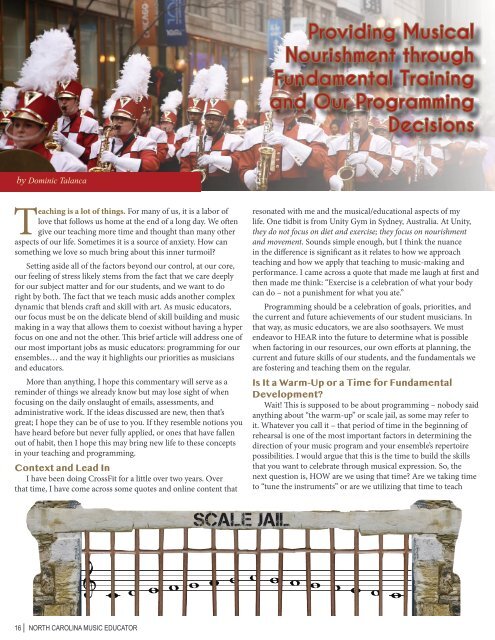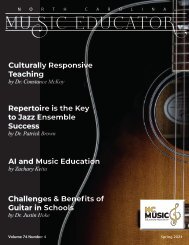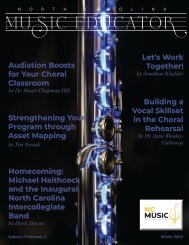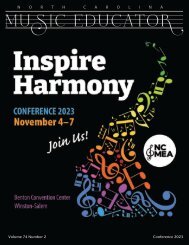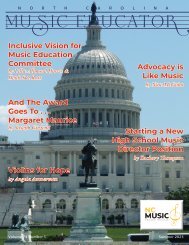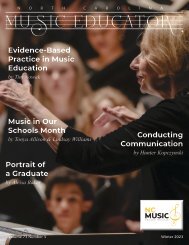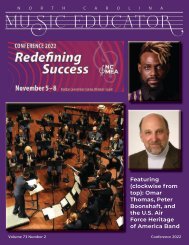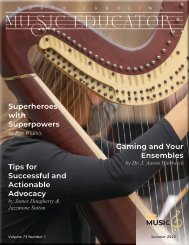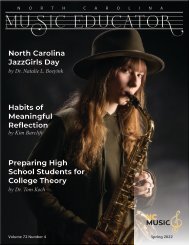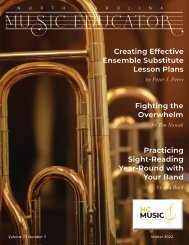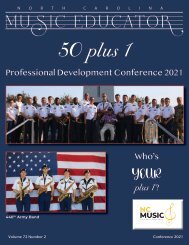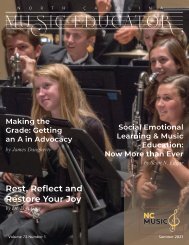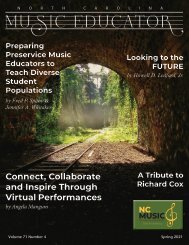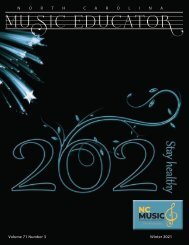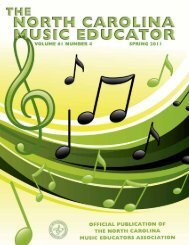NC Music Educator Winter 2020
North Carolina Music Educator Journal Winter 2020
North Carolina Music Educator Journal Winter 2020
Create successful ePaper yourself
Turn your PDF publications into a flip-book with our unique Google optimized e-Paper software.
y Dominic Talanca<br />
Teaching is a lot of things. For many of us, it is a labor of<br />
love that follows us home at the end of a long day. We often<br />
give our teaching more time and thought than many other<br />
aspects of our life. Sometimes it is a source of anxiety. How can<br />
something we love so much bring about this inner turmoil?<br />
Setting aside all of the factors beyond our control, at our core,<br />
our feeling of stress likely stems from the fact that we care deeply<br />
for our subject matter and for our students, and we want to do<br />
right by both. The fact that we teach music adds another complex<br />
dynamic that blends craft and skill with art. As music educators,<br />
our focus must be on the delicate blend of skill building and music<br />
making in a way that allows them to coexist without having a hyper<br />
focus on one and not the other. This brief article will address one of<br />
our most important jobs as music educators: programming for our<br />
ensembles… and the way it highlights our priorities as musicians<br />
and educators.<br />
More than anything, I hope this commentary will serve as a<br />
reminder of things we already know but may lose sight of when<br />
focusing on the daily onslaught of emails, assessments, and<br />
administrative work. If the ideas discussed are new, then that’s<br />
great; I hope they can be of use to you. If they resemble notions you<br />
have heard before but never fully applied, or ones that have fallen<br />
out of habit, then I hope this may bring new life to these concepts<br />
in your teaching and programming.<br />
Context and Lead In<br />
I have been doing CrossFit for a little over two years. Over<br />
that time, I have come across some quotes and online content that<br />
SCALE JAIL<br />
Providing <strong>Music</strong>al<br />
Nourishment through<br />
Fundamental Training<br />
and Our Programming<br />
Decisions<br />
resonated with me and the musical/educational aspects of my<br />
life. One tidbit is from Unity Gym in Sydney, Australia. At Unity,<br />
they do not focus on diet and exercise; they focus on nourishment<br />
and movement. Sounds simple enough, but I think the nuance<br />
in the difference is significant as it relates to how we approach<br />
teaching and how we apply that teaching to music-making and<br />
performance. I came across a quote that made me laugh at first and<br />
then made me think: “Exercise is a celebration of what your body<br />
can do – not a punishment for what you ate.”<br />
Programming should be a celebration of goals, priorities, and<br />
the current and future achievements of our student musicians. In<br />
that way, as music educators, we are also soothsayers. We must<br />
endeavor to HEAR into the future to determine what is possible<br />
when factoring in our resources, our own efforts at planning, the<br />
current and future skills of our students, and the fundamentals we<br />
are fostering and teaching them on the regular.<br />
Is It a Warm-Up or a Time for Fundamental<br />
Development?<br />
Wait! This is supposed to be about programming – nobody said<br />
anything about “the warm-up” or scale jail, as some may refer to<br />
it. Whatever you call it – that period of time in the beginning of<br />
rehearsal is one of the most important factors in determining the<br />
direction of your music program and your ensemble’s repertoire<br />
possibilities. I would argue that this is the time to build the skills<br />
that you want to celebrate through musical expression. So, the<br />
next question is, HOW are we using that time? Are we taking time<br />
to “tune the instruments” or are we utilizing that time to teach<br />
students to use their ears and adjust? Are we progressing through<br />
a routine to get through the warm-up, or are we creating variety<br />
in a way that requires students and teacher to mentally and aurally<br />
remain on their toes?<br />
The most creative educators can utilize 45+ minutes on skillbuilding/fundamentals<br />
in a 90-minute rehearsal in an engaging<br />
way. I am not saying half of every rehearsal should be used in<br />
this way, but I contend if we look at how we use that opening<br />
segment of time in our rehearsal, we can create something more<br />
developmental and less “routine-oriented.” Productive doesn’t<br />
necessarily mean short.<br />
Fighting the Good Fight<br />
Have you ever thought, “I love that piece, but it was more work<br />
than it was worth, and I won’t be teaching it again?” I know I have.<br />
Being honest with myself, I think it really means I programmed<br />
something that I wanted to do, but the students did not have the<br />
current fundamental skillset with the appropriate trajectory for<br />
improvement to perform at the standard that I’d like to instill in<br />
them as musicians. It may also mean I didn’t plan well enough to<br />
foster the growth of those skills during our fundamental sequence<br />
to make it possible.<br />
Keeping with the theme of performance being a celebration<br />
of what our students can do, we do not want every piece to feel<br />
stressful to rehearse/teach. That’s not fun or rewarding for anyone<br />
involved. It’s not wrong to program a heavy hitter, but we should<br />
ask ourselves how many of those pieces are being programmed<br />
in one concert cycle and whether it is conducive to achieving our<br />
larger set of goals. Our repertoire/programming is our curriculum.<br />
This means that simply playing a particular piece should not be the<br />
goal – it should be the tool/vehicle used to tend to a larger agenda.<br />
Back to Fundamentals<br />
We have established that the fundamental/skill-building<br />
portion of our rehearsal can be utilized in a productive or<br />
unproductive way. We may also agree we do not want to feel like<br />
it is soul crushing to learn the repertoire we program. With these<br />
ideas in mind, I would offer the thought that, in an ideal world,<br />
our fundamental sequence would be the most challenging thing<br />
we do. This is not always possible, but if we strive to challenge<br />
our students by building their fundamental skillset, then we can<br />
make learning repertoire an exercise in the application of their<br />
fundamentals and not rely solely on our ability to teach (force feed)<br />
the piece.<br />
If students only experience the most extreme tessituras,<br />
dynamics, tempi, articulations, intervallic or tonal expectations,<br />
etc. in our chosen repertoire, there is no way the performance<br />
will be as mature as it could be if those things were a focus in the<br />
fundamental portion of rehearsal. There are too many elements in<br />
much of our repertoire to expect students to learn the necessary<br />
skills in addition to executing them at the same time.<br />
It’s Not One or the Other<br />
I want to be clear, I’m not proposing only performing music<br />
that is easily achieved. I am just suggesting we ask ourselves what<br />
the piece is doing to serve the larger set of goals we have for our<br />
students and ourselves as musicians/educators. Our fundamentals<br />
and chosen compositions can build musical muscle, but I am also<br />
suggesting we include pieces that are not back breakers – those<br />
pieces that allow for heightened focus and work on the nontechnical<br />
aspects of music making. More clearly put: we should<br />
pair repertoire that builds musical muscle with those pieces that<br />
allow for the most mature and sophisticated musical expression<br />
and nuance possible. The easy pieces are only easy if we do not<br />
use the available brainpower to focus on more sophisticated ideas.<br />
Can we, as educators, identify special musical opportunities in our<br />
repertoire?<br />
What’s on the Menu and Don’t Skip Leg Day<br />
We have all heard the analogies relating programming and<br />
repertoire selection to a buffet or even a balanced diet. We should<br />
all feel obligated to ask, how are we nourishing our musicians?<br />
Have we fallen into certain programming ruts by neglecting or<br />
favoring music that is comprised of similar characteristics or<br />
challenges? The qualities are too countless to list in this setting, but<br />
diversity in all regards is a necessity for the musical nourishment of<br />
our students and of our own musicianship. When programming,<br />
we have all selected music to highlight the strengths and hide<br />
the weaknesses of our ensemble, but how often do we take good<br />
risks to grow and nourish the things that need attention? Are you<br />
skipping leg day?<br />
<strong>Music</strong>ianship First<br />
Most of us were musicians before we decided to be educators. I<br />
think it is worthwhile to frequently remind ourselves of that. I am<br />
a musician. I am a musician. I am a musician. I noticed that as my<br />
skills in rehearsing, cleaning, fixing, etc. improved, I became more<br />
focused on the craft of being a band director, and I lost sight of<br />
the need to imbue my own musicianship into the ensemble I was<br />
teaching. As teachers, we become good at eliminating unsavory<br />
moments (i.e. fixing stuff that’s wrong), but does the music we<br />
select have opportunities to create special musical moments that<br />
make us say “YES!”? What do those special moments look like?<br />
I don’t know; they are unique to each individual and unique to<br />
each composition. Every piece in a concert should be different, and<br />
the compositions should reveal to us, the teachers, the things that<br />
deserve special musical attention.<br />
Final Stretch<br />
Developing musical muscle through skill building is imperative.<br />
However, it is more important to look for ways to use that muscle<br />
to support our musical endeavors through the performance of a<br />
varied repertoire, in turn providing nourishment to our students<br />
and ourselves. Yes, pick pieces that challenge students not only<br />
technically, but also choose pieces that look easy so time can be<br />
spent celebrating and expanding upon their musical vocabulary<br />
in performance as well. Our priorities as musicians and educators<br />
should draw a clear line to our curriculum and programming.<br />
It is possible to be a great teacher while never forgetting we are<br />
musicians first.<br />
Dominic Talanca is assistant professor of<br />
music, and director of bands, music education<br />
and conducting at U<strong>NC</strong> – Wilmington<br />
16 | NORTH CAROLINA MUSIC EDUCATOR NORTH CAROLINA MUSIC EDUCATOR | 17


